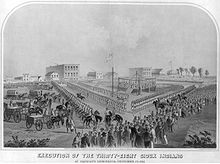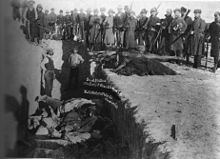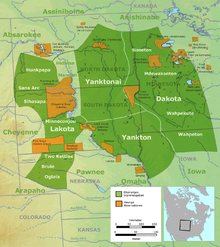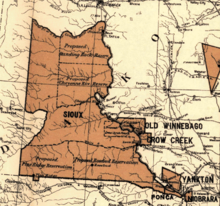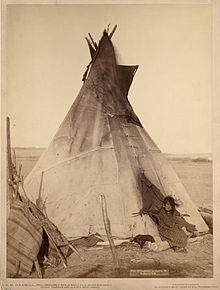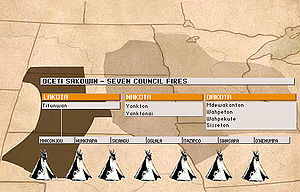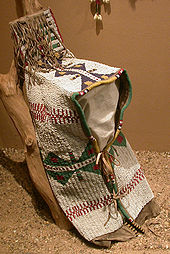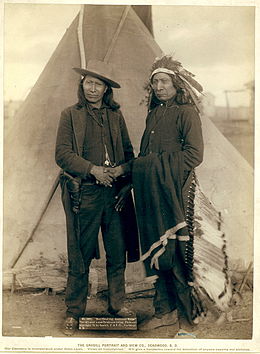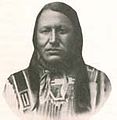- Sioux
-
This article is about the ethnic group. For the passenger train, see Sioux (passenger train).Not to be confused with Sault (disambiguation).
Sioux
Očhéthi Šakówiŋ
Sitting Bull, a Hunkpapa Lakota chief and holy man, circa 1885. Total population 150,000+[1][2] Regions with significant populations  United States (SD, MN, NE, MT, ND),
United States (SD, MN, NE, MT, ND),
 Canada (MB, SK, AB)
Canada (MB, SK, AB)Languages Religion Christianity (incl. syncretistic forms), Midewiwin
Related ethnic groups Assiniboine, Stoney (Nakoda), and other Siouan peoples
The Sioux (
 /ˈsuː/) are Native American and First Nations people in North America. The term can refer to any ethnic group within the Great Sioux Nation or any of the nation's many language dialects. The Sioux comprise three major divisions based on Siouan dialect and subculture:
/ˈsuː/) are Native American and First Nations people in North America. The term can refer to any ethnic group within the Great Sioux Nation or any of the nation's many language dialects. The Sioux comprise three major divisions based on Siouan dialect and subculture:- Isáŋyathi or Isáŋathi ("Knife," originating from the name of a lake in present-day Minnesota): residing in the extreme east of the Dakotas, Minnesota and northern Iowa, and are often referred to as the Santee or Eastern Dakota.
- Iháŋktȟuŋwaŋ and Iháŋktȟuŋwaŋna ("Village-at-the-end" and "little village-at-the-end"): residing in the Minnesota River area, they are considered to be the middle Sioux, and are often referred to as the Yankton and the Yanktonai, or, collectively, as the Wičhíyena (endonym) or the Western Dakota (and have been erroneously classified as “Nakota”[3]) .
- Thítȟuŋwaŋ or Teton (uncertain, perhaps "Dwellers on the Prairie"; this name is archaic among the natives, who prefer to call themselves Lakȟóta[4]): the westernmost Sioux, known for their hunting and warrior culture, are often referred to as the Lakota.
Today, the Sioux maintain many separate tribal governments scattered across several reservations, communities, and reserves in the Dakotas, Nebraska, Minnesota, and Montana in the United States; and Manitoba and southern Saskatchewan in Canada.
Name origins
The name "sune" is an abbreviated form of Nadouessioux borrowed into Canadian French from Nadoüessioüak from the early Odawa exonym: naadowesiwag "Sioux".[5] Jean Nicolet recorded the use in 1640.[6] The Proto-Algonquian form *na·towe·wa, meaning "Northern Iroquoian", has reflexes in several daughter languages that refer to a small rattlesnake (massasauga, Sistrurus).[7] This information was interpreted by some that the Ottawa borrowing was an insult. However, this Proto-Algonquian term most likely was ultimately derived from a form *-a·towe·, meaning simply "to speak a foreign language".[5] Later this was extended in meaning in some Algonquian languages to refer to the massasauga. Thus, contrary to many accounts, the old Odawa word naadowesiwag did not equate the Sioux with snakes. This is not confirmed though, since usage over the previous decades has led to this term having negative connotations to those tribes to which it refers. This would explain why many tribes have rejected this term as an exonym.
Some of the tribes have formally or informally adopted traditional names: the Rosebud Sioux Tribe is also known as the Sičháŋǧu Oyáte, and the Oglala often use the name Oglála Lakȟóta Oyáte, rather than the English "Oglala Sioux Tribe" or OST. The alternative English spelling of Ogallala is considered improper.[6]
Očhéthi Šakówiŋ
The historical Sioux referred to the Great Sioux Nation as the Očhéthi Šakówiŋ (pronounced [oˈtʃʰetʰi ʃaˈkowĩ]), meaning "Seven Council Fires". Each fire was a symbol of an oyate (people or nation). The seven nations that comprise the Sioux are: Bdewákaŋthuŋwaŋ (Mdewakanton), Waȟpéthuŋwaŋ (Wahpeton), Waȟpékhute (Wahpekute), Sisíthuŋwaŋ (Sisseton), the Iháŋkthuŋwaŋ (Yankton), Iháŋkthuŋwaŋna (Yanktonai), and the Thítȟuŋwaŋ (Teton or Lakota).[6] The Seven Council Fires would assemble each summer to hold council, renew kinships, decide tribal matters, and participate in the Sun Dance.[8] The seven divisions would select four leaders known as Wičháša Yatápika from among the leaders of each division.[8] Being one of the four leaders was considered the highest honor for a leader; however, the annual gathering meant the majority of tribal administration was cared for by the usual leaders of each division. The last meeting of the Seven Council Fires was in 1850.[8]
Today the Teton, Santee, and Ihantowan/Ihanktowana are usually known, respectively, as the Lakota, Eastern Dakota, or Western Dakota.[4][6] In any of the three main dialects, "Lakota" or "Dakota" translate to mean "friend," or more properly, "ally." Usage of Lakota or Dakota may then refer to the alliance that once bound the Great Sioux Nation.
History
Early history
The Dakotas are first recorded to have resided at the source of the Mississippi river during the seventeenth century.[9] By 1700 some of them relocated to present-day South Dakota.[10] Late in the 17th century, the Dakota entered into an alliance with French merchants.[11] The French were trying to gain advantage in the struggle for the North American fur trade against the English, who had recently established the Hudson's Bay Company.
Dakota War of 1862
Main article: Dakota War of 1862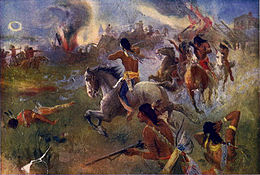 Siege of New Ulm, August 19, 1862.
Siege of New Ulm, August 19, 1862. Drawing of the mass hanging of Dakota in Mankato, Minnesota
Drawing of the mass hanging of Dakota in Mankato, Minnesota
By 1862, shortly after a failed crop the year before and a winter starvation, the federal payment was late. The local traders would not issue any more credit to the Santee and one trader, Andrew Myrick, went so far as to say, "If they're hungry, let them eat grass."[12] On August 17, 1862 the Dakota War began when a few Santee men murdered a white farmer and most of his family. They inspired further attacks on white settlements along the Minnesota River. The Santee attacked the trading post. Later settlers found Myrick among the dead with his mouth stuffed full of grass.[13]
On November 5, 1862 in Minnesota, in courts-martial, 303 Santee Sioux were found guilty of rape and murder of hundreds of American settlers. They were sentenced to be hanged. No attorneys or witness were allowed as a defense for the accused, and many were convicted in less than five minutes of court time with the judge.[14] President Abraham Lincoln commuted the death sentence of 284 of the warriors, while signing off on the execution of 38 Santee men by hanging on December 26, 1862 in Mankato, Minnesota. It was the largest mass-execution in U.S. history.[15]
Afterwards, the US suspended treaty annuities to the Dakota for four years and awarded the money to the white victims and their families. The men remanded by order of President Lincoln were sent to a prison in Iowa, where more than half died.[14]
During and after the revolt, many Santee and their kin fled Minnesota and Eastern Dakota to Canada, or settled in the James River Valley in a short-lived reservation before being forced to move to Crow Creek Reservation on the east bank of the Missouri.[14] A few joined the Yanktonai and moved further west to join with the Lakota bands to continue their struggle against the United States military.[14]
Others were able to remain in Minnesota and the east, in small reservations existing into the 21st century, including Sisseton-Wahpeton, Flandreau, and Devils Lake (Spirit Lake or Fort Totten) Reservations in the Dakotas. Some ended up in Nebraska, where the Santee Sioux Tribe today has a reservation on the south bank of the Missouri.
Those who fled to Canada now have descendants residing on nine small Dakota Reserves, five of which are located in Manitoba (Sioux Valley, Long Plain, Dakota Tipi, Birdtail Creek, and Oak Lake [Pipestone]) and the remaining four (Standing Buffalo, Moose Woods [White Cap], Round Plain [Wahpeton], and Wood Mountain) in Saskatchewan.
Red Cloud's War
Main article: Red Cloud's WarRed Cloud's War (also referred to as the Bozeman War) was an armed conflict between the Lakota and the United States in the Wyoming Territory and the Montana Territory from 1866 to 1868. The war was fought over control of the Powder River Country in north central Wyoming.
The war is named after [[Red Cloud], a prominent Sioux chief who led the war against the United States following encroachment into the area by the U.S. military. The war ended with the Treaty of Fort Laramie. The Sioux victory in the war led to their temporarily preserving their control of the Powder River country.[16]
Great Sioux War of 1876-77
Main article: Great Sioux War of 1876-77The Great Sioux War comprised a series of battles between the Lakota and allied tribes such as the Cheyenne against the United States military. The earliest engagement was the Battle of Powder River, and the final battle was the Wolf Mountain. Included are the Battle of the Rosebud, Battle of the Little Bighorn, Battle of Warbonnet Creek, Battle of Slim Buttes, Battle of Cedar Creek, and the Dull Knife Fight.
Wounded Knee Massacre
Main article: Wounded Knee MassacreThe massacre at Wounded Knee Creek was the last major armed conflict between the Lakota and the United States. It was described as a "massacre" by General Nelson A. Miles in a letter to the Commissioner of Indian Affairs.[17]
On December 29, 1890, five hundred troops of the U.S. 7th Cavalry, supported by four Hotchkiss guns (a lightweight artillery piece capable of rapid fire), surrounded an encampment of the Lakota bands of the Miniconjou and Hunkpapa [18] with orders to escort them to the railroad for transport to Omaha, Nebraska.
By the time it was over, 25 troopers and more than 150 Lakota Sioux lay dead, including men, women, and children. Some of the soldiers are believed to have been the victims of "friendly fire" because the shooting took place at point-blank range in chaotic conditions.[19] Around 150 Lakota are believed to have fled the chaos, many of whom may have died from hypothermia.[citation needed]
Reserves and First Nations
Later in the 19th century, the railroads hired hunters to exterminate the buffalo herds, the Indians' primary food supply. The Santee and Lakota were forced to accept white-defined reservations in exchange for the rest of their lands, and domestic cattle and corn in exchange for buffalo. They became dependent upon annual federal payments guaranteed by treaty.
In Minnesota, the treaties of Traverse des Sioux and Mendota in 1851 left the Sioux with a reservation twenty miles (32 km) wide on each side of the Minnesota River. Today, one half of all enrolled Sioux in the United States live off the reservation. Enrolled members in any of the Sioux tribes in the United States are required to have ancestry that is at least 1/4 degree Sioux (the equivalent to one grandparent).[20]
In Canada, the Canadian government recognizes the tribal community as First Nations. The land holdings of the these First Nations are called Indian Reserves.
Modern reservations, reserves, and communities of the Sioux
Reserve/Reservation Community Bands residing Location Fort Peck Indian Reservation Assiniboine and Sioux Tribes Hunkpapa, Upper Yanktonai (Pabaksa), Mdewakantonwan, Wahpekute, Sisseton, Wahpeton, Assiniboine (Canoe Paddler, Red Bottom) Montana, USA Spirit Lake Reservation (Formerly Devil's Lake Reservation)
Spirit Lake Tribe (Mni Wakan Oyate)
Wahpeton, Sisseton, Upper Yanktonai North Dakota, USA Standing Rock Indian Reservation Standing Rock Sioux Tribe Upper Yanktonai, Hunkpapa North Dakota, South Dakota, USA Lake Traverse Indian Reservation Sisseton Wahpeton Oyate Sisseton, Wahpeton South Dakota, USA Flandreau Indian Reservation Flandreau Santee Sioux Tribe Mdewakanton, Wahpekute, Wahpeton South Dakota, USA Cheyenne River Indian Reservation Cheyenne River Sioux Tribe Minneconjou, Blackfoot, Two Kettle, Sans Arc South Dakota, USA Crow Creek Indian Reservation Crow Creek Sioux Tribe Lower Yanktonai South Dakota, USA Lower Brule Indian Reservation Lower Brule Sioux Tribe Brulé South Dakota, USA Yankton Sioux Indian Reservation Yankton Sioux Tribe Yankton South Dakota, USA Pine Ridge Indian Reservation Oglala Lakota Oglala, few Brulé South Dakota, USA Rosebud Indian Reservation Rosebud Sioux Tribe (also as Sicangu Lakota or Upper Brulé Sioux Nation) (Sičháŋǧu Oyate)
Sićangu (Brulé), few Oglala South Dakota, USA Upper Sioux Indian Reservation Upper Sioux Community (Pejuhutazizi Oyate)
Mdewakanton, Sisseton, Wahpeton Minnesota, USA Lower Sioux Indian Reservation Lower Sioux Indian Community Mdewakanton, Wahpekute Minnesota, USA Shakopee-Mdewakanton Indian Reservation (Formerly Prior Lake Indian Reservation)
Shakopee Mdewakanton Sioux Community Mdewakanton, Wahpekute Minnesota, USA Prairie Island Indian Community Prairie Island Indian Community Mdewakanton, Wahpekute Minnesota, USA Santee Indian Reservation Santee Sioux Nation Mdewakanton, Wahpekute Nebraska, USA Sioux Valley Dakota Nation Reserve, Fishing Station 62A Reserve* Sioux Valley First Nation Sisseton, Mdewakanton, Wahpeton, Wahpekute Manitoba, Canada Dakota Plains Indian Reserve 6A Dakota Plains Wahpeton First Nation Wahpeton, Sisseton Manitoba, Canada Dakota Tipi 1 Reserve Dakota Tipi First Nation Wahpeton Manitoba, Canada Birdtail Creek 57 Reserve, Birdtail Hay Lands 57A Reserve, Fishing Station 62A Reserve* Birdtail Sioux First Nation Mdewakanton, Wahpekute, Yanktonai Manitoba, Canada Canupawakpa Dakota First Nation Reserve, Oak Lake 59A Reserve, Fishing Station 62A Reserve* Canupawakpa Dakota Nation Wahpekute, Wahpeton, Yanktonai Manitoba, Canada Standing Buffalo 78 Reserve Standing Buffalo Dakota First Nation Sisseton, Wahpeton Saskatchewan, Canada Whitecap Reserve Whitecap Dakota First Nation Wahpeton, Sisseton Saskatchewan, Canada Dakota Plains Wahpeton First Nation Wahpeton Saskatchewan, Canada Wood Mountain 160 Reserve, Treaty Four Reserve Grounds Indian Reservation 77* Wood Mountain Hunkpapa Saskatchewan, Canada - * Reserves shared with other First Nations
20th century activism
Wounded Knee incident
-
Main article: Wounded Knee incident
Beginning in the late 1960s, young Native Americans began to agitate for improved conditions, respect for their civil rights, and better programs in education and economic development. Dramatic protests were conceived, such as the occupation of Alcatraz Island in California.
The Wounded Knee incident began February 27, 1973 when the town of Wounded Knee, South Dakota was seized by followers of the American Indian Movement. The occupiers controlled the town for 71 days while various state and federal law enforcement agencies such as the F.B.I. and the United States Marshals Service laid siege. Two members of A.I.M. were killed by gunfire during the incident.
Republic of Lakotah
Main article: Republic of LakotahThe Lakotah Freedom Delegation, a group of controversial Native American activists, declared on December 19, 2007 the Lakotah were withdrawing from all treaties signed with the United States to regain sovereignty over their nation. One of the activists, Russell Means, claims that the action is legal and cites Natural, International and U.S. law.[21] The group considers Lakotah to be a sovereign nation, although as yet the state is generally unrecognized. The proposed borders reclaim thousands of square kilometres of North and South Dakota, Wyoming, Nebraska and Montana.[22]
Political organization
The historical political organization was based on individual participation and the cooperation of many to sustain the tribe’s way of life. Leaders were chosen based upon noble birth and demonstrations of chiefly virtues, such as bravery, fortitude, generosity, and wisdom.[8]
- Political leaders were members of the Načá Omníčiye society and decided matters of tribal hunts, camp movements, whether to make war or peace with their neighbors, or any other community action.[23]
- Societies were similar to fraternities; men joined to raise their position in the tribe. Societies were composed of smaller clans and varied in number among the seven divisions.[8] There were two types of societies: Akíčhita, for the younger men, and Načá, for elders and former leaders.[8]
- Akíčhita (Warrior) societies existed to train warriors, hunters, and to police the community.[23] There were many smaller Akíčhita societies, including the Kit-Fox, Strong Heart, Elk, and so on.[23]
- Leaders in the Načá societies, per Načá Omníčiye, were the tribal elders and leaders. They elected seven to ten men, depending on the division, each referred to as Wičháša Itȟáŋčhaŋ ("chief man"). Each Wičháša Itȟáŋčhaŋ interpreted and enforced the decisions of the Načá.[23]
- The Wičháša Itȟáŋčhaŋ would elect two to four Shirt Wearers, who were the voice of the society. They settled quarrels among families and also foreign nations.[8] Shirt Wearers were often young men from families with hereditary claims of leadership. However, men with obscure parents who displayed outstanding leaderships skills and had earned the respect of the community might also be elected. Crazy Horse is an example of a common-born "Shirt Wearer".[8]
- A Wakíčhuŋza ("Pipe Holder") ranked below the "Shirt Wearers". The Pipe Holders regulated peace ceremonies, selected camp locations, and supervised the Akíčhita societies during buffalo hunts.[23]
Linguistics
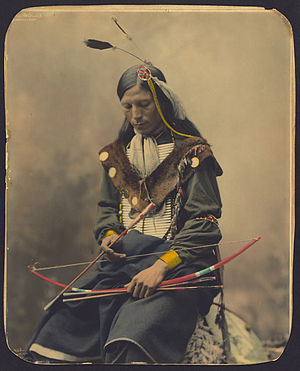 Chief Bone Necklace an Oglala Lakota from the Pine Ridge Indian Reservation (1899)
Chief Bone Necklace an Oglala Lakota from the Pine Ridge Indian Reservation (1899)
The Sioux comprise three closely related language groups:
- Eastern Dakota (a.k.a. Santee-Sisseton or Dakhóta)
- Santee (Isáŋyáthi: Bdewákhathuŋwaŋ, Waȟpékhute)
- Sisseton (Sisíthuŋwaŋ, Waȟpéthuŋwaŋ)
- Western Dakota (a.k.a. Yankton-Yanktonai or Dakȟóta)
- Yankton (Iháŋktȟuŋwaŋ)
- Yanktonai (Iháŋktȟuŋwaŋna)
- Lakota (a.k.a. Lakȟóta, Teton, Teton Sioux)
The earlier linguistic three-way division of the Sioux language identified Lakota, Dakota, and Nakota as dialects of a single language, where Lakota = Teton, Dakota = Santee-Sisseton and Nakota = Yankton-Yanktonai.[7] However, the latest studies [4][24] show that Yankton-Yanktonai never used the autonym Nakhóta, but pronounced their name roughly the same as the Santee (i.e. Dakȟóta).
These later studies identify Assiniboine and Stoney as two separate languages, with Sioux being the third language. Sioux has three similar dialects: Lakota, Western Dakota (Yankton-Yanktonai) and Eastern Dakota (Santee-Sisseton). Assiniboine and Stoney speakers refer to themselves as Nakhóta or Nakhóda[4] (cf. Nakota).
The term Dakota has also been applied by anthropologists and governmental departments to refer to all Sioux groups, resulting in names such as Teton Dakota, Santee Dakota, etc. This was mainly because of the misrepresented translation of the Ottawa word from which Sioux is derived.[8] they usually lived in ti-pis such as shown in the picture, that they would all set up together as a tribe.
Modern geographic divisions
 Funeral scaffold of a Sioux chief (Karl Bodmer)
Funeral scaffold of a Sioux chief (Karl Bodmer)
The Sioux maintain many separate tribal governments scattered across several reservations and communities in North America: in the Dakotas, Minnesota, Nebraska, and Montana in the United States; and in Manitoba, southern Saskatchewan and Alberta in Canada.
The earliest known European record of the Sioux identified them in Minnesota, Iowa, and Wisconsin.[7] After the introduction of the horse in the early 18th century, the Sioux dominated larger areas of land—from present day Central Canada to the Platte River, from Minnesota to the Yellowstone River, including the Powder River country.[23]
Santee (Isáŋyathi or Eastern Dakota)
The Santee migrated north and westward from the Southeast United States, first into Ohio, then to Minnesota. Some came up from the Santee River and Lake Marion, area of South Carolina. The Santee River was named after them, and some of their ancestors' ancient earthwork mounds have survived along the portion of the dammed-up river that forms Lake Marion. In the past, they were a Woodland people who thrived on hunting, fishing and subsistence farming.
Migrations of Anishinaabe/Chippewa (Ojibwa) people from the east in the 17th and 18th centuries, with muskets supplied by the French and British, pushed the Dakota further into Minnesota and west and southward. The US gave the name "Dakota Territory" to the northern expanse west of the Mississippi River and up to its headwaters.[7]
Iháŋkthuŋwaŋ-Iháŋkthuŋwaŋna (Yankton-Yanktonai or Western Dakota)
The Iháŋkthuŋwaŋ-Iháŋkthuŋwaŋna, also known by the anglicized spelling Yankton (Iháŋkthuŋwaŋ: "End village") and Yanktonai (Iháŋkthuŋwaŋna: "Little end village") divisions consist of two bands or two of the seven council fires. According to Nasunatanka and Matononpa in 1880, the Yanktonai are divided into two sub-groups known as the Upper Yanktonai and the Lower Yanktonai (Hunkpatina).[7]
They were involved in quarrying pipestone. The Yankton-Yanktonai moved into northern Minnesota. In the 18th century, they were recorded as living in the Mankato region of Minnesota.[25]
Lakota (Teton or Thítȟuŋwaŋ)
Main article: Lakota peopleThe Sioux likely obtained horses sometime during the seventeenth century (although some historians date the arrival of horses in South Dakota to 1720, and credit the Cheyenne with introducing horse culture to the Lakota). The Teton (Lakota) division of the Sioux emerged as a result of this introduction. Dominating the northern Great Plains with their light cavalry, the western Sioux quickly expanded their territory further to the Rocky Mountains (which they call Heska, "white mountains"). The Lakota once subsisted on the buffalo hunt, and on corn. They acquired corn mostly through trade with the eastern Sioux and their linguistic cousins, the Mandan and Hidatsa along the Missouri.[7]
Ethnic divisions
The Sioux are divided into three ethnic groups, the larger of which are divided into sub-groups, and further branched into bands.
- The Santee live on reservations, reserves, and communities in Minnesota, Nebraska, South Dakota, North Dakota, and Canada.
- Most of the Yanktons live on the Yankton Reservation in southeastern South Dakota. Some Yankton live on the Lower Brule Indian Reservation and Crow Creek Reservation. The Yanktonai are divided into Lower Yanktonai, who occupy the Crow Creek Reservation; and Upper Yanktonai, who live in the northern part of Standing Rock Reservation, on the Spirit Lake Reservation in central North Dakota, and in the eastern half of the Fort Peck Reservation in northeastern Montana. In addition, they reside at several Canadian reserves, including Birdtail, Oak Lake, and Moose Woods.[4]
- The Lakota are the westernmost of the three groups, occupying lands in both North and South Dakota.
Today, many Sioux also live outside their reservations.
- Santee division (Eastern Dakota) (Isáŋyathi)[4]
- Mdewakantonwan (Bdewékhaŋthuŋwaŋ "Spirit Lake Village")[4]
- notable persons: Taoyateduta
- Sisseton (Sisíthuŋwaŋ, perhaps meaning "Fishing Grounds Village")
- Wahpekute (Waȟpékhute, "Leaf Archers")[4]
- notable persons: Inkpaduta
- Wahpetonwan (Waȟpéthuŋwaŋ, "Leaf Village")[4]
- Mdewakantonwan (Bdewékhaŋthuŋwaŋ "Spirit Lake Village")[4]
- Yankton-Yanktonai division (Western Dakota) (Wičhíyena)
- Yankton (Iháŋkthuŋwaŋ, "End Village")[4]
- Yanktonai (Iháŋkthuŋwaŋna, "Little End Village")[4]
- Upper Yanktonai
- Unkpatina[26] or Lower Yanktonai
- notable persons: Wanata, Chief War Eagle
- Teton division (Lakota) (Thítȟuŋwaŋ,[4] perhaps meaning "Dwellers on the Prairie"):
- Oglála (perhaps meaning "Those Who Scatter Their Own")
- notable persons: Crazy Horse, Red Cloud, Black Elk and Billy Mills (Olympian)
- Hunkpapa (Húŋkpapȟa,[4] meaning "Those who Camp by the Door" or "Wanderers")
- notable persons: Sitting Bull
- Sihasapa (Sihásapa, "Blackfoot Sioux,"[4] not to be confused with the Algonquian-speaking Blackfeet)
- Minniconjou (Mnikȟówožu, "Those who Plant by Water")[4]
- notable persons: Lone Horn, Touch the Clouds
- Brulé (French translation of Sičháŋǧu, "Burned Thigh")[4]
- Sans Arcs (French translation of Itázipčho, "Those Without Bows")[4]
- Two Kettles (Oóhenupa, "Two Boilings")[4]
- Oglála (perhaps meaning "Those Who Scatter Their Own")
In popular media
Video clip of a dance performed by a Sioux tribe from Buffalo Bill's Wild West show. This is part of a group of films constituting the first appearance of Native Americans in motion pictures
- The Richard Harris film A Man Called Horse and its two sequels depicts Sioux customs and histories.
- The HBO movie Bury My Heart at Wounded Knee depicts the relocation and reservations of the people from the Sioux perspective, based on the book by Dee Brown.
- The films Dances with Wolves and Thunderheart contain depictions of the Sioux People.
- "Elegy to the Sioux," a poem by Norman Dubie
- The mini-series Into the West depicts the Sioux, specifically the Lakota, during some of first ventures of the "white men" into the Great Plains and the Rocky Mountains.
- The novel A Death for Beauty depicts the Lakota Sioux and their battles with the U.S. Cavalry during the Civil War.
- The Film Hidalgo depicts the events of Frank Hopkins, a rider for the United States Army, who was at the Wounded Knee Massacre as he wrestles with his Sioux heritage.
- Aaron Huey's TED presentation "America's Native Prisoners of War." - Sept. 2010[27]
- Diane Sawyer Takes an In-Depth look at the Young Dreamers and Survivors of the Pine Ridge Indian Reservation, Fighting Against Decades of Neglect Airing Friday, October 14, 2011 on ABC
Famous Sioux
Historical
- Siŋté Gleśká (Spotted Tail) — Brulé chief who resisted joining Red Cloud's War
- Thaóyate Dúta (Little Crow) — Chief famous for role in the Dakota War of 1862
- Tȟatȟáŋka Íyotake (Sitting Bull) — Chief famous for role in the Battle of Little Bighorn
- Tȟašúŋke Witkó (Crazy Horse) — Famous for leadership and courage in battle
- Maȟpíya Ičáȟtagye (Touch the Clouds) - Famous for his legendary strength and size, a great warrior
- Maȟpíya Lúta (Red Cloud) — Chief famous for role in Red Cloud's War
- Tȟašúŋke Kȟokípȟapi (Young Man Afraid Of His Horses) — Oglala chief who participated in Red Cloud's War
- Ištáȟba (Sleepy Eye) — Chief of the Sisseton band in the mid-19th century; signed four treaties[28]
- Heȟáka Sápa (Black Elk) — Lakota holy man, source of Black Elk Speaks and other books
- Tȟáȟča Hušté (Lame Deer) — Lakota holy man, carried traditional knowledge into modern era
- Ohíyes’a (Charles Eastman) — Author, physician and reformer
- Colonel Gregory "Pappy" Boyington — World War II Fighter Ace and Medal of Honor recipient; 1/4 Sioux
- Waŋbdí Tháŋka (Big Eagle) - Mdewakanton Dakota chief who narrated his account of the Dakota War of 1862
- Tamaha (One Eye) - Mdewekanton Dakota chief who supported the United States in the War of 1812.
- Iŋkpáduta (Scarlet Point) - Waȟpékhute Dakota chief famous for his indomitable opposition to US forces (he took part in all the Sioux Wars from the 1857 Spirit Lake Massacre to the Battle of Little Bighorn, and fought until he died)
- Xunka Kuciyedano (Low Dog), Oglala chief who fought with Sitting Bull at the Little Bighorn
Contemporary
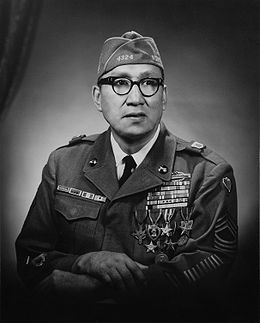 Woodrow Keeble, Medal of Honor recipient.
Woodrow Keeble, Medal of Honor recipient.
- Robert "Tree" Cody, Native American flutist (Dakota)
- Elizabeth Cook-Lynn, activist, academic, and writer
- Mary Crow Dog, writer and activist
- Vine Deloria, Jr., activist and essayist
- Indigenous, blues band (Nakota)
- Illinois Jacquet, jazz saxophonist (half Sioux and half African American)
- Eddie Little Sky, actor (Oglala)
- Russell Means, activist (Oglala)
- Ed McGaa, author, (Oglala) CPT US Marine Corp F-4 Phantom Fighter Pilot
- Billy Mills, only American ever to win the 10,000 meters at the Olympics (1964) – Oglala
- Eddie Spears, actor (Lakota Sioux Lower Brule)
- Michael Spears, actor (Lakota Sioux Lower Brule)
- Terry Ree, comedian
- John Trudell, activist, poet, actor (Dakota)
- Floyd Red Crow Westerman, singer and actor (Dakota)
- Kim Winona (1930–1978), actress
- Leonard Peltier, activist, imprisoned for allegedly killing two FBI agents in 1975
- Woodrow Keeble, (Sisseton Wahpeton Oyate) first Sioux Medal of Honor recipient for his valor during the Korean War
- Luther Standing Bear, Sioux author, actor, and rights activist
- J. Medicine Hat, Comedian, and hypnotist.
- Chaske Spencer, actor
- Waziyatawin (a.k.a. Angela Wilson), author, professor, and activist (from the Upper Sioux Community/Pezihutazizi)
Legacy
A Manitoba Historical Plaque was erected at the Spruce Woods Provincial Park by the province to commemorate Assiniboin (Nakota) First Nation's role in Manitoba's heritage.[29]
Gallery
-
-
Wahktageli ("Gallant Warrior",[30] a Yankton Sioux chief (Karl Bodmer)
References
- ^ "United States Census Data" (PDF). http://www.census.gov/statab/www/sa04aian.pdf. Retrieved 2007-08-11.
- ^ "Ethnologue Report for Lakota". http://www.ethnologue.com/show_language.asp?code=lkt. Retrieved 2007-08-11.
- ^ for a report on the long-established blunder of misnaming as “Nakota”, the Yankton and the Yanktonai, see the article Nakota
- ^ a b c d e f g h i j k l m n o p q r Ullrich, Jan (2008). New Lakota Dictionary (Incorporating the Dakota Dialects of Yankton-Yanktonai and Santee-Sisseton). Lakota Language Consortium. pp. 1–2. ISBN 0-9761082-9-1.
- ^ a b "Sioux". Dictionary.com. http://dictionary.reference.com/browse/sioux. Retrieved 2007-09-05.
- ^ a b c d e Johnson, Michael (2000). The Tribes of the Sioux Nation. Osprey Publishing Oxford. ISBN 185532878X.
- ^ a b c d e f Riggs, Stephen R. (1893). Dakota Grammar, Texts, and Ethnography. Washington Government Printing Office, Ross & Haines, Inc.. ISBN 0-87018-052-5.
- ^ a b c d e f g h i Hassrick, Royal B.; Dorothy Maxwell, Cile M. Bach (1964). The Sioux: Life and Customs of a Warrior Society. University of Oklahoma Press. ISBN 0-8061-0607-7.
- ^ Hyde, George E. (1984), Red Cloud's Folk: A History of the Oglala Sioux Indians, Norman: University of Oklahoma Press, p. 3, ISBN 0806115203
- ^ Johnson, Michael; Smith, Jonathan (2000), Tribes of the Sioux Nation, Oxford: Osprey Publishing, p. 3, ISBN 185532878X
- ^ van Houten, Gerry (1991), Corporate Canada An Historical Outline, Toronto: Progress Books, pp. 6–7, ISBN 0919396542
- ^ Dillon, Richard (1993). North American Indian Wars. City: Booksales. p. 126. ISBN 1555219519.
- ^ Steil, Mark; Tim Post (2002-09-26). "Let them eat grass". Minnesota Public Radio. http://news.minnesota.publicradio.org/features/200209/23_steilm_1862-m/part2.shtml. Retrieved 2011-09-21.
- ^ a b c d War for the Plains. Time-Life Books. 1994. ISBN 0-8094-9445-0.
- ^ Steil, Mark; Tim Post (2002-09-26). "Execution and expulsion". Minnesota Public Radio. http://news.minnesota.publicradio.org/features/200209/23_steilm_1862-m/part5.shtml. Retrieved 2011-10-02.
- ^ *Brown, Dee (1970). Bury My Heart at Wounded Knee, ch. 6. Bantam Books. ISBN 0-5531-1979-6.
- ^ Letter: General Nelson A. Miles to the Commissioner of Indian Affairs, March 13, 1917.
- ^ Liggett, Lorie (1998). "Wounded Knee Massacre - An Introduction". Bowling Green State University. http://www.bgsu.edu/departments/acs/1890s/woundedknee/WKIntro.html. Retrieved 2007-03-02.
- ^ Strom, Karen (1995). "The Massacre at Wounded Knee". Karen Strom. http://www.hanksville.org/daniel/lakota/Wounded_Knee.html.
- ^ "Enrollment Ordinance". http://www.tribalresourcecenter.org/ccfolder/sisseton_wahpeton_codeoflaw2.htm. Retrieved 2007-08-11.
- ^ Descendants of Sitting Bull and Crazy Horse break away from US, Agence France-Presse news
- ^ Bill Harlan (21 December 2007). "Lakota group secedes from U.S.". Rapid City Journal. http://www.rapidcityjournal.com/articles/2007/12/21/news/local/doc476a99630633e335271152.txt. Retrieved 2007-12-28.
- ^ a b c d e f Mails, Thomas E. (1973). Dog Soldiers, Bear Men, and Buffalo Women: A Study of the Societies and Cults of the Plains Indians. Prentice-Hall, Inc.. ISBN 013-217216-X.
- ^ Parks, D. R.; DeMallie, R. J. (1992). "Sioux, Assiniboine, and Stoney Dialects: a Classification". Anthropological Linguistics 34 (1-4).
- ^ OneRoad, Amos E.; Alanson Skinner (2003). Being Dakota: Tales and Traditions of the Sisseton and Wahpeton. Minnesota Historical Society. ISBN 0-87351-453-X.
- ^ not to be confused with the Oglala thiyóšpaye bearing the same name, "Unkpatila", the most famous member of which was Crazy Horse
- ^ http://www.ted.com/talks/aaron_huey.html
- ^ Upham, Warren (2001). Minnesota Place Names, A Geographical Encyclopedia, 3rd Edition. Saint Paul, Minnesota: Minnesota Historical Society. p. 75. ISBN 0-87351-396-7.
- ^ Manitoba Plaque
- ^ [1]
Further reading
- Hassrick, Royal B (1977), The Sioux: life and customs of a warrior society, University of Oklahoma Press, ISBN 0806106077, http://books.google.ca/books?id=SiJT9rK6YugC&lpg=PP1&dq=Sioux&pg=PP1#v=onepage&q&f=true
- Gibbon, Guy E (2003), The Sioux: the Dakota and Lakota nations, Blackwell, ISBN 1557865663, http://books.google.ca/books?id=Y8WyblLdXYIC&lpg=PP1&dq=Sioux&pg=PP1#v=onepage&q&f=true
- McLaughlin, Marie L (2006), Myths and Legends of the Sioux, BiblioBazaar, LLC, ISBN 489496826, http://books.google.ca/books?id=GL1Q5Twhg9gC&lpg=PP1&dq=Sioux&pg=PP1#v=onepage&q&f=true
- Hyde, George E (1993), A Sioux chronicle, University of Oklahoma Press, ISBN 0806124830, http://books.google.ca/books?id=iyOGOGPN9FkC&lpg=PP1&dq=Sioux&pg=PP1#v=onepage&q&f=true
- Standing Bear, Luther; E A Brininstool (2006), My People the Sioux, University of Nebraska Press, ISBN 0803293321, http://books.google.ca/books?id=ltSXg-abnU4C&lpg=PP1&dq=Sioux&pg=PP1#v=onepage&q&f=true
External links
- Myths And Legends Of The Sioux
- Native American Heritage Association NAHA - Native American Heritage Association Charity Organization
Categories:- Sioux
- Plains tribes
Wikimedia Foundation. 2010.

